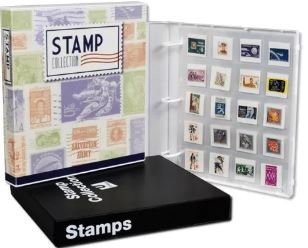Stamp collecting is a rewarding hobby that can also be a lucrative investment. Whether you’ve been collecting stamps for years or are just starting, how to preserve stamp collections is a critical question that every collector needs to answer. Preserving your stamps properly not only safeguards their value but also ensures they remain in pristine condition for years to come. However, without proper care, you risk damaging your valuable stamps. In this article, we’ll dive deep into how to preserve stamp collections, providing you with expert tips on maintaining your collection and pointing out common pitfalls to avoid.

Why It’s Important to Preserve Stamp Collections
Before delving into how to preserve stamp collections, it’s essential to understand why preservation matters. Stamps are often delicate, with thin paper and intricate designs that can easily be damaged. Over time, environmental factors such as humidity, light exposure, and physical handling can cause irreversible damage to your stamps, leading to a decrease in their value. Proper preservation techniques help to:
- Maintain Value: Well-preserved stamps can fetch higher prices in the market, whether you’re selling or trading them.
- Enhance Longevity: Preservation ensures that your stamps remain intact for years, preserving both their aesthetic and historical value.
- Organize and Protect: The right storage techniques prevent stamps from becoming damaged or lost within your collection.
Now that you know the importance of preservation, let’s explore how to preserve stamp collections in more detail.
1. Store Stamps in the Right Environment
One of the most crucial aspects of how to preserve stamp collections is ensuring that they are stored in the proper environment. Exposure to heat, humidity, or light can cause stamps to fade, discolor, or warp. Here’s how to create the ideal environment for your collection:
- Temperature and Humidity: Stamps should be stored in a cool, dry environment, ideally between 60-70°F (15-21°C) with a humidity level of 40-50%. Extreme temperature fluctuations can cause the paper to expand and contract, leading to damage.
- Avoid Direct Sunlight: UV rays from direct sunlight can cause fading and discoloration. Always store your stamps in a location where they are protected from prolonged exposure to sunlight.
- Use Acid-Free Storage Materials: Store your stamps in acid-free materials, as acidic paper can cause yellowing and deterioration over time.
2. Use Proper Stamp Storage Supplies
When it comes to how to preserve stamp collections, the materials you use to store your stamps are just as important as the environment. Choosing the right supplies will help prevent physical damage and preserve the condition of your stamps for years. Here are some tips:
- Stamp Albums: The most popular option for storing stamps is a stamp album. Make sure the album you choose has acid-free pages or plastic sleeves. These albums come in a variety of styles, from traditional binders to more modern, archival-quality albums.
- Stock Books and Stock Pages: For a more flexible storage solution, stock books and stock pages are excellent choices. These pages allow you to store your stamps without placing them in direct contact with the album, minimizing the risk of damage.
- Mounts and Hinges: For valuable stamps, it’s essential to use stamp mounts or hinges. Mounts are clear, adhesive-free holders that protect your stamps from direct contact with paper or plastic, which can cause damage over time. Hinges are small, paper-based tools that allow you to attach stamps to album pages without causing harm.

3. Handle Stamps with Care
Proper handling is one of the most important aspects of how to preserve stamp collections. Improper handling can result in bent corners, creases, or even tearing. Follow these guidelines to handle your stamps safely:
- Use Tweezers: Always use acid-free, soft-tipped tweezers when handling your stamps. This prevents oils from your fingers from transferring to the stamp and reduces the risk of bending or damaging it.
- Avoid Touching the Stamp Surface: Never touch the face of the stamp with your fingers. Instead, handle stamps by their edges to avoid transferring dirt, oil, or moisture that could damage the paper or ink.
- Work on a Clean Surface: When working with your stamps, always use a clean, smooth, and soft surface, such as a stamp mat or a cloth, to avoid accidental damage.
4. Regularly Inspect Your Collection
One of the best ways to ensure the preservation of your collection is to regularly inspect your stamps for signs of damage or deterioration. How to preserve stamp collections doesn’t end with proper storage—it’s an ongoing process that involves checking your stamps periodically. Look for:
- Fading: Check if the ink or colors have started to fade. If you notice fading, you may need to adjust the storage conditions or move the stamp to a more protected environment.
- Moisture Damage: Check for signs of moisture or mold, especially if your collection has been stored in a humid environment. If you find any issues, take immediate action to remedy the situation.
- Paper Deterioration: Look for signs of paper thinning, yellowing, or brittleness. If your stamps show these signs, they may need to be re-housed in better protective materials.
5. Avoid Common Pitfalls When Preserving Stamps
While how to preserve stamp collections is crucial, many collectors unknowingly make mistakes that can compromise their collection’s value and integrity. Here are some common pitfalls to avoid:
- Using Non-Archival Materials: Avoid using materials that are not acid-free, such as regular paper or non-archival plastic sleeves. These materials can cause yellowing or stick to your stamps, causing damage.
- Storing Stamps in Plastic Bags: Many collectors make the mistake of storing stamps in plastic bags, which can trap moisture and create an environment conducive to mold growth. Always use proper archival-quality materials instead.
- Exposing Stamps to Extreme Conditions: Storing stamps in basements, attics, or other areas with fluctuating temperatures and high humidity can lead to significant damage. Always store stamps in a stable, controlled environment.
- Cleaning Stamps Improperly: Never clean stamps with water, chemicals, or abrasive materials. Cleaning can cause irreversible damage to your stamps. If your stamps are dirty, consult a professional conservator for advice.
6. Invest in Insurance and Documentation
Finally, another important aspect of how to preserve stamp collections is safeguarding your investment. If your collection is particularly valuable, consider obtaining insurance to protect it from theft, fire, or other disasters. Additionally, it’s a good idea to maintain a detailed inventory, complete with descriptions, photographs, and estimated values for each stamp.

Conclusion
How to preserve stamp collections is not just about storing stamps safely—it’s about protecting your investment and ensuring your collection remains in optimal condition for years to come. By following the right practices, using appropriate storage materials, handling your stamps with care, and regularly inspecting your collection, you can avoid the common pitfalls that damage valuable stamps. Remember, preserving your collection is an ongoing process that requires attention and effort, but it will pay off in the long run as you safeguard your stamps’ beauty and value.
With the right knowledge and precautions, you’ll be well on your way to enjoying a well-preserved and highly valuable stamp collection for generations to come. Don’t settle for hasty or careless preservation practices—take the time to preserve your stamps properly and avoid the costly mistakes many collectors make.




